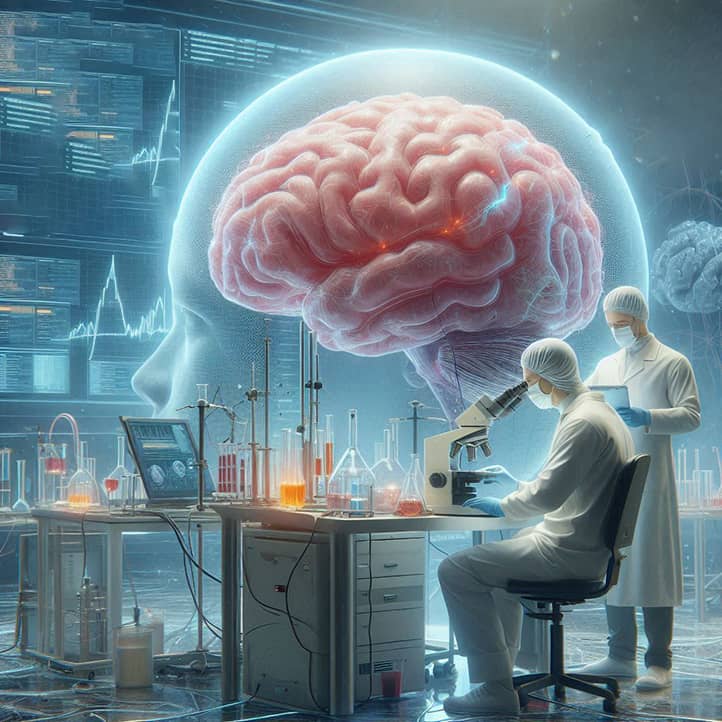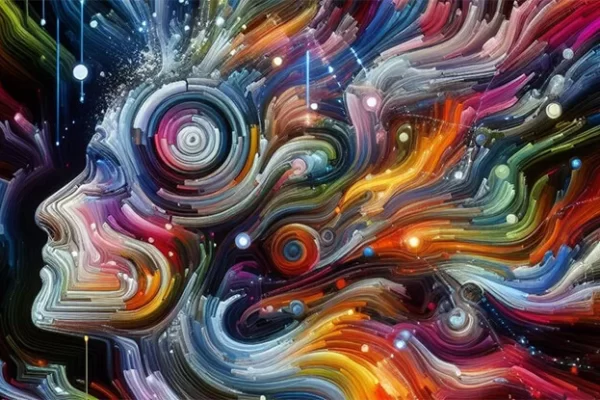Dissociative Identity Disorder (DID) – one of the most complex and controversial mental conditions in modern psychiatry, previously known as multiple personality disorder, is characterized by the presence of two or more distinct identities or personality states that alternately control the individual’s behavior.
This disorder often raises confusion and skepticism among the public and even some mental health professionals. However, for those who suffer from DID, it is a very real and often destructive condition that can severely disrupt their daily life and functioning.
The history of studying dissociative identity disorder dates back to the late 19th century when French psychologist Pierre Janet first described a case of “split personality.” Since then, our understanding of this disorder has significantly evolved, although many aspects of DID remain the subject of scientific discussion and research.

Dissociative Identity Disorder: Symptoms and Manifestations
The human psyche possesses an amazing ability to adapt, even in the most extreme conditions. Dissociative Identity Disorder exemplifies how the mind can respond to unbearable stress by creating multiple versions of itself.
Similar to an actor changing masks on stage, a person with DID experiences the existence of different “selves,” each with its own history, character, and memories. This inner drama unfolds not only in the mind but also manifests outwardly, affecting all aspects of the person’s life.
Key Signs of the Disorder
Dissociative Identity Disorder is characterized by several specific symptoms that can vary in intensity and frequency. Key signs include:
- The presence of two or more distinct identities or personality states, each with its relatively stable pattern of perceiving, thinking, and relating to the world and oneself.
- Amnesia or memory lapses that go beyond ordinary forgetfulness. The person may not remember important personal events, information, or actions taken by another identity.
- A sense of detachment from one’s own emotions, thoughts, or actions, as if observing oneself from the outside.
- Feelings of unreality regarding the surrounding world or one’s own existence (derealization and depersonalization).
- Sudden changes in behavior, speech, mannerisms, or even physical characteristics when switching between identities.
- Difficulty with self-identification and a feeling of internal conflict between different aspects of oneself.
- Auditory hallucinations, which may be interpreted as the “voices” of other identities.
Types of Alter Personalities
Alter personalities, or “alters,” are separate identities that exist within the framework of DID. They can differ significantly in age, gender, ethnicity, temperament, and even physical characteristics. Some common types of alter personalities include:
- Child: Often represents a “frozen” part of the personality carrying childhood trauma.
- Protector: A personality that takes on the role of protecting the primary identity or other alters from danger.
- Persecutor: May be an internalized abuser or the embodiment of self-criticism and self-punishment.
- Helper: An alter who assists in daily tasks or managing other personalities.
- Opposite gender: A personality expressing repressed aspects of gender identity.
- Animal: A rare type of alter that may reflect a strong connection to nature or a coping mechanism.
- Idealized personality: The embodiment of desirable but unattainable qualities for the primary identity.
It is important to note that the number and types of alter personalities can vary widely from case to case, and some people with DID may have dozens or even hundreds of different alters.
Impact on Daily Life
Dissociative Identity Disorder can profoundly impact all aspects of an individual’s life:
- Professional activities: Frequent switches between personalities can make it difficult to fulfill work responsibilities and maintain a stable career.
- Relationships: Close ones may struggle with communication and building trust due to unpredictable changes in behavior and personality.
- Self-care: Some alter personalities may neglect basic bodily needs, leading to health and hygiene issues.
- Finances: Different personalities may have varying financial habits, leading to unpredictable spending and financial difficulties.
- Education: Memory lapses and concentration difficulties can seriously hinder learning.
- Legal aspects: In rare cases, the actions of one identity may lead to legal problems, of which the primary personality may not be aware.
- Emotional well-being: Constant internal struggle and a sense of lost control over one’s own life can lead to depression, anxiety, and other emotional issues.
People with DID often describe their lives as chaotic and unpredictable, which can lead to social isolation and a significant decrease in quality of life. However, with the right diagnosis and treatment, it is possible to learn to manage this condition and lead a fulfilling life.

Causes and Risk Factors
Behind DID lies a complex web of interactions between traumatic experiences, brain biology, and environmental factors. Similar to how an earthquake can alter the landscape, profound psychological trauma can reshape the very structure of the personality.
However, not everyone who experiences trauma develops Dissociative Identity Disorder. This disorder can be compared to a rare flower that only blooms under a certain combination of soil, climate, and care. Understanding these factors sheds light on the nature of DID and opens avenues for prevention and treatment.
Traumatic Childhood Experiences
The primary cause of dissociative identity disorder is considered to be severe traumatic experiences in early childhood. This often includes:
- Physical abuse: Systematic beatings or other forms of physical abuse from parents or guardians.
- Sexual abuse: Incest, rape, or other forms of sexual abuse, especially if they occur regularly and over a long period.
- Emotional abuse: Constant humiliation, insults, neglect of the child’s emotional needs.
- Witnessing violence: Observing violence towards other family members or close individuals.
- Extreme situations: Wars, natural disasters, kidnappings, or other life-threatening situations for the child.
DID is believed to develop as a defense mechanism, allowing the child to “escape” from an unbearable reality. By creating alternative personalities, the child’s psyche tries to cope with the trauma, isolating the traumatic experience and the emotions associated with it.
It is important to note that not all children who experience trauma develop dissociative identity disorder. Factors that may increase the likelihood of developing the disorder include:
- The age at which the trauma occurred (the younger, the higher the risk).
- The frequency and duration of traumatic events.
- Lack of support or protection from other adults.
- Innate heightened susceptibility to dissociation.
Genetic Predisposition
While traumatic experience is considered the primary factor in the development of DID, research indicates that genetic predisposition may also play a role. Genetic factors can influence:
- Tendency to dissociate: Some people may have a genetic predisposition to use dissociation as a coping mechanism.
- Neuroplasticity: Genetic factors may affect the brain’s ability to adapt and change in response to traumatic experiences.
- Stress vulnerability: Genetically determined differences in stress response may affect the likelihood of developing DID in response to trauma.
- Emotional regulation: Genes associated with emotional regulation may affect the ability to cope with traumatic experiences.
Twin method and family research have shown that first-degree relatives of individuals with dissociative identity disorder have an increased risk of developing this disorder. However, it is important to emphasize that the presence of a genetic predisposition does not mean the inevitable development of DID. Genetic factors are more likely to create “soil” on which traumatic experiences can lead to the development of the disorder.
Neurobiological Aspects
Modern research in neurobiology is beginning to shed light on the brain mechanisms underlying dissociative identity disorder. Some key findings include:
- Changes in brain structure: Studies using neuroimaging methods have shown a reduction in the volume of the hippocampus and amygdala in people with DID. These structures play an important role in emotion processing and memory formation.
- Disturbances in neural network functioning: Functional MRI studies have revealed changes in connections between different areas of the brain in people with DID, especially in networks related to self-awareness and emotional regulation.
- Alterations in neurotransmitter systems: Abnormalities in serotonin and norepinephrine systems have been identified, which may affect mood, attention, and memory.
- Dysfunction in the hypothalamus-pituitary-adrenal axis: This system, responsible for the stress response, often works abnormally in people with DID, which may explain increased sensitivity to stress.
- Epigenetic changes: Traumatic experiences can cause long-term changes in gene expression, affecting the functioning of the nervous system and response to stress.
These neurobiological changes can explain many DID symptoms, including issues with memory, emotional regulation, and sense of self. However, the relationship between trauma, neurobiological changes, and the symptoms of dissociative identity disorder is complex and not fully understood.
Understanding the neurobiological foundations of DID opens up new possibilities for diagnosis and treatment. For example, neuroimaging methods may, in the future, help in diagnosing DID, while understanding neurochemical changes may lead to the development of more effective pharmacological treatments.
However, despite the growing understanding of the biological aspects of dissociative identity disorder, it is important to remember that this disorder is the result of a complex interplay of biological, psychological, and social factors. An integrated approach that takes all these aspects into account remains the most effective for understanding and treating DID.

Diagnosis
In the world of mental disorders, Dissociative Identity Disorder (DID) is often compared to an enigmatic puzzle. Its symptoms frequently resemble those of other conditions, and the true nature of the disorder may remain concealed for a long time, even from an experienced specialist.
The diagnostic process for DID resembles the work of an investigator gathering clues and evidence. Each piece of information—whether patient memories, observations from loved ones, or psychological test results—contributes to forming a comprehensive picture of the disorder.
DSM-5 Criteria
The diagnosis of DID is based on the criteria established in the Diagnostic and Statistical Manual of Mental Disorders (DSM-5), developed by the American Psychiatric Association. According to DSM-5, the following criteria must be present to diagnose Dissociative Identity Disorder:
- Identity disruption characterized by two or more distinct personality states, which may be described in some cultures as possession. Identity disruption includes noticeable changes in perception, thought, memory, and behavior.
- Recurrent gaps in memory for everyday events, important personal information, and/or traumatic events that are beyond ordinary forgetfulness.
- Symptoms cause clinically significant distress or impairments in social, occupational, or other important areas of functioning.
- The disturbance is not part of a broadly accepted cultural or religious practice.
- Symptoms are not explained by the direct physiological effects of a substance (e.g., memory loss or chaotic behavior during alcohol intoxication) or a general medical condition (e.g., complex partial seizures).
It’s important to note that diagnosing DID is often complicated due to the complexity of symptoms and their similarity to other mental disorders. Additionally, many individuals with DID may conceal their symptoms or lack full awareness of them.
Assessment Methods and Diagnostic Tools
Diagnosing Dissociative Identity Disorder requires careful assessment and often includes the use of various methods and tools:
- Clinical Interview: A detailed conversation with the patient about their symptoms, life history, and traumatic experiences.
- Structured Clinical Interview for DSM-5 (SCID-5): A standardized tool for assessing mental disorders.
- Dissociative Experiences Scale (DES): A self-report questionnaire that assesses the frequency of dissociative symptoms.
- Structured Clinical Interview for Dissociative Disorders (SCID-D): A specialized tool for assessing dissociative disorders.
- Rorschach Test and other projective techniques: Can reveal the presence of different personality states.
- Multimodal Dissociation Inventory (MDI): Evaluates various aspects of dissociation.
- Neuropsychological Testing: May detect cognitive impairments associated with DID.
- Physiological Measurements: For example, electroencephalography (EEG) may reveal differences in brain activity when switching between personalities.
It is essential that the diagnosis is conducted by an experienced specialist familiar with DID’s unique characteristics and capable of distinguishing it from other conditions.
Differential Diagnosis
Differential diagnosis of Dissociative Identity Disorder is especially important because many of its symptoms may resemble other mental disorders. Conditions that need to be ruled out or differentiated include:
- Other dissociative disorders: Such as dissociative amnesia or depersonalization-derealization disorder.
- Post-Traumatic Stress Disorder (PTSD): Often co-occurs with DID but may also share similar symptoms.
- Borderline Personality Disorder: Characterized by instability in interpersonal relationships, self-image, and mood.
- Bipolar Disorder: Extreme mood swings can be mistaken for personality changes.
- Schizophrenia: Hallucinations and delusions may resemble some symptoms of DID.
- Epilepsy, especially complex partial seizures: Can cause altered states of consciousness.
- Malingering: Deliberate demonstration of DID symptoms for gain.
- Substance-Induced Disorder: May lead to behavioral and personality changes.
- Histrionic Personality Disorder: Characterized by excessive emotionality and attention-seeking.
Proper differential diagnosis is critically important for determining the most effective treatment plan. Often, a prolonged observation period and symptom assessment in various contexts are required for an accurate diagnosis.

Treatment of Dissociative Identity Disorder
The treatment of Dissociative Identity Disorder can be compared to fine-tuning a complex musical instrument. Each personality, like an individual string, requires special attention and approach to ultimately create harmonious resonance.
The journey to recovery in DID is often winding and full of unexpected turns. It requires not only the therapist’s professionalism but also great courage and patience from the patient. This journey towards wholeness brings the individual closer to a fuller understanding and acceptance of themselves.
Psychotherapeutic Approaches
Psychotherapy is the primary treatment method for Dissociative Identity Disorder. The goal of therapy is to help the patient integrate different personality aspects, process traumatic experiences, and learn to manage everyday tasks more effectively. Main psychotherapeutic approaches include:
- Phase-Oriented Therapy:
- Phase 1: Stabilization and symptom reduction.
- Phase 2: Processing traumatic memories.
- Phase 3: Personality integration and rehabilitation.
- Cognitive Behavioral Therapy (CBT): Helps to change maladaptive thoughts and behaviors related to trauma and dissociation.
- Dialectical Behavior Therapy (DBT): Teaches skills for emotion regulation and interpersonal effectiveness.
- Eye Movement Desensitization and Reprocessing (EMDR): Helps process traumatic memories.
- Hypnotherapy: Can assist in accessing dissociated memories and states.
- Psychodynamic Therapy: Explores the impact of past experiences on current issues.
- Group Therapy: Provides support and the opportunity to share experiences with others with DID.
- Family Therapy: Aims to improve relationships with loved ones and create a supportive environment.
DID therapy is often lengthy and intensive, requiring significant time and emotional resources from both the patient and therapist.
Medication Therapy
While there are no specific medications for treating Dissociative Identity Disorder, medication therapy may be useful for alleviating comorbid symptoms and conditions:
- Antidepressants (SSRIs): Help with depression, anxiety, and post-traumatic symptoms.
- Anxiolytics: May be prescribed for short-term anxiety reduction.
- Mood Stabilizers: Aid in emotional stability.
- Antipsychotic Drugs: Sometimes used in low doses to reduce dissociative symptoms.
- Sleep Aids: Prescribed for sleep issues.
It’s important to note that medications do not directly treat Dissociative Identity Disorder but can relieve some symptoms and improve the patient’s quality of life. Any medication therapy should be conducted under careful medical supervision.
Personality Integration as a Therapy Goal
Personality integration is often considered the ultimate goal of DID therapy, although not all specialists and patients consider complete integration necessary. The integration process may involve the following stages:
- Awareness: Helping the patient become aware of the existence and functions of different personalities.
- Communication: Establishing connections between different personality states.
- Cooperation: Teaching the various personalities to work together towards common goals.
- Conflict Resolution: Working on resolving internal conflicts between personalities.
- Synthesis: Gradual merging of different personality aspects.
- Integration: Complete fusion of the various states into a unified, more complex personality.
It’s essential to note that the integration process can be lengthy and emotionally challenging. Some patients may achieve a satisfactory level of life quality without complete integration by learning to effectively interact between different personality states.

Social Aspects
In a society that often seeks simple explanations, dissociative identity disorder (DID) challenges conventional ideas about the unity of self. This disorder acts as a mirror, reflecting our fears and biases about the nature of human consciousness.
Living with DID in the modern world is like navigating a maze of social norms and expectations. Every interaction, whether at work, within the family, or in daily life, requires special caution and understanding from both the person with DID and the people around them.
Stigmatization and Myths about the Disorder
Dissociative identity disorder is often surrounded by numerous myths and misconceptions, leading to stigmatization of individuals with this diagnosis. Some common myths include:
- Myth: DID is a fictional or rare condition. Fact: Dissociative identity disorder is a real mental health disorder recognized by the psychiatric community.
- Myth: People with DID are dangerous and unpredictable. Fact: Most people with DID do not pose a threat to others.
- Myth: Dissociative identity disorder is the same as schizophrenia. Fact: These are distinct disorders with different symptoms and causes.
- Myth: Alter personalities are always aware of each other. Fact: The degree of awareness between personalities can vary.
- Myth: Dissociative identity disorder is easy to fake. Fact: DID symptoms are complex and consistent, making them difficult to convincingly imitate over long periods.
Stigmatization can lead to social isolation, difficulties in accessing healthcare, and discrimination in various areas of life. Education and public awareness about DID are critically important to overcoming this stigma.
Support from Family and Loved Ones
The role of family and loved ones in supporting a person with dissociative identity disorder cannot be overstated. Here are some key aspects of such support:
- Education: Family members should strive to learn more about DID to better understand their loved one’s condition.
- Emotional support: Showing patience, understanding, and acceptance is essential.
- Practical assistance in daily tasks, including reminders for taking medications and attending therapy.
- Creating a safe environment: Ensuring a stable and predictable home setting.
- Respecting boundaries: Understanding that the person with DID may need personal space at times.
- Participating in therapy: Family therapy can be beneficial for improving communication and mutual understanding.
- Self-care: Family members should also care for their mental health, possibly attending support groups for relatives.
Legal and Ethical Issues
Dissociative identity disorder raises several complex legal and ethical issues:
- Legal capacity: The ability of a person with DID to make legally significant decisions may be questioned.
- Criminal liability: The question of whether a person with DID can be held accountable for actions committed in one of their alternate states remains a matter of debate.
- Confidentiality: How can information about different personalities within one patient be kept confidential?
- Informed consent: How to obtain informed consent for treatment if different personalities have different preferences?
- Ethical aspects of integration: Are there ethical issues in “erasing” separate personalities during integration?
- Labor law: How to protect the rights of an employee with DID and ensure fair treatment in the workplace?
- Child custody: How to address custody issues if one of the parents has a DID diagnosis?
- Health insurance: Should dissociative identity disorder be covered by insurance on par with other mental disorders?
These questions require careful consideration and often an individual approach in each case. It is important for the legal system and society as a whole to develop a deeper understanding of DID to ensure fair and ethical treatment of people with this disorder.

Modern Research and Perspectives
Just as the Hubble Telescope opened new horizons in the universe, modern brain research methods allow us to peer into the deepest corners of the human psyche. Therefore, the future of DID research promises to be as thrilling as exploring distant galaxies.
Each new discovery not only expands our understanding of this complex disorder but also brings us closer to unraveling one of nature’s greatest mysteries—the mystery of human consciousness.
New Diagnostic and Treatment Methods
Research into dissociative identity disorder continues to advance, opening up new possibilities for diagnosis and treatment:
- Neuroimaging:
- Functional magnetic resonance imaging (fMRI) allows observation of changes in brain activity during personality switching.
- Diffusion tensor imaging (DTI) helps to study structural changes in brain white matter in people with DID.
- Genetic Studies:
- Studying genetic markers associated with increased susceptibility to dissociation.
- Epigenetic studies showing how traumatic experiences can influence gene expression.
- Biomarkers:
- Searching for specific biological markers of DID in the blood or other bodily fluids.
- Virtual Reality (VR):
- Using VR to create a controlled environment for exposure therapy.
- VR as a tool for studying body perception and self-awareness in people with DID.
- Transcranial Magnetic Stimulation (TMS):
- Investigating the possibility of using TMS to modulate brain activity and reduce DID symptoms.
- Pharmacological Studies:
- Developing new medications specifically aimed at dissociative symptoms.
- Examining the effects of psychedelic substances (e.g., MDMA, ketamine) in controlled therapeutic settings.
- Integrative Approaches:
- Combining various treatment methods (psychotherapy, medications, neuromodulation) to achieve a synergistic effect.
- Machine Learning and Artificial Intelligence:
- Developing algorithms for analyzing speech patterns and behavior for early DID diagnosis.
Unresolved Questions and Future Research Directions
Despite significant progress in understanding dissociative identity disorder, many questions remain open and require further research:
- Mechanisms of Alter Personality Formation:
- How exactly does traumatic experience lead to the formation of separate personalities?
- Why do some people with traumatic experiences develop DID, while others do not?
- Neurobiological Basis of Switching Between Personalities:
- What specific neural networks are involved in the switching process?
- Is it possible to predict or control switches on a neurobiological level?
- Long-Term Consequences of Personality Integration:
- How does integration affect brain functioning in the long term?
- Are there cases of spontaneous integration, and what causes them?
- Cultural Aspects of DID:
- How do cultural factors influence the manifestation and perception of DID?
- Are there culturally specific forms of DID?
- Early Diagnosis and Prevention:
- Can early signs of DID be detected in children who have experienced trauma?
- What preventive measures can reduce the risk of developing DID in traumatized children?
- Treatment Optimization:
- What combinations of therapeutic approaches are most effective?
- How to personalize treatment, considering individual patient characteristics?
- Relationship with Other Disorders:
- How is dissociative identity disorder related to other trauma-related disorders?
- Are there common mechanisms with other dissociative states?
- Social Adaptation:
- What strategies are most effective for improving the social functioning of people with DID?
- How to optimize support for family and loved ones?
- Ethical Issues in Research:
- How to conduct ethical research with people with DID, considering the vulnerability of this group?
- Long-Term Prognosis:
- What factors influence the long-term prognosis of DID?
- Is “full recovery” a feasible goal for DID?
These research directions not only help better understand dissociative identity disorder but also lead to the development of more effective methods for diagnosing, treating, and supporting individuals with this complex disorder.

Conclusion
Dissociative identity disorder is one of the most intriguing mysteries in mental health. This condition, characterized by the presence of multiple personalities, challenges our understanding of the human psyche and identity. Over the decades, DID has been a subject of debate and discussion, but modern research increasingly confirms its reality and seriousness.
The origins of dissociative identity disorder lie in profound traumatic experiences, especially in early childhood. This fact underscores the importance of prevention and early intervention in cases of child abuse. However, the development of the disorder also depends on a complex interaction of genetic, neurobiological, and social factors, making each case of DID unique.
Diagnosing and treating dissociative identity disorder remain complex tasks requiring high professionalism and a multidisciplinary approach. Psychotherapy, especially aimed at personality integration, plays a key role in treatment, but other support methods, including medication for comorbid symptoms, are also essential.
The social aspects of dissociative identity disorder are as important as the clinical ones. Stigmatization and misunderstanding often exacerbate the suffering of people with this disorder. Raising public awareness about DID can significantly improve the quality of life for patients and their loved ones, contributing to more effective social integration and support.
The future of DID research looks promising. New neuroimaging methods, genetic research, and innovative therapeutic approaches open new horizons in understanding and treating this disorder. These advancements will not only help individuals with DID but also shed light on fundamental questions about the nature of consciousness and identity.
It is important to remember that behind each case of dissociative identity disorder is a real person experiencing profound internal conflicts. Compassion, understanding, and professional assistance play a crucial role in improving these individuals’ lives. As our understanding of DID deepens, so too does the hope for more effective treatments and support methods that will help people with this disorder achieve inner harmony and a fulfilling life.




